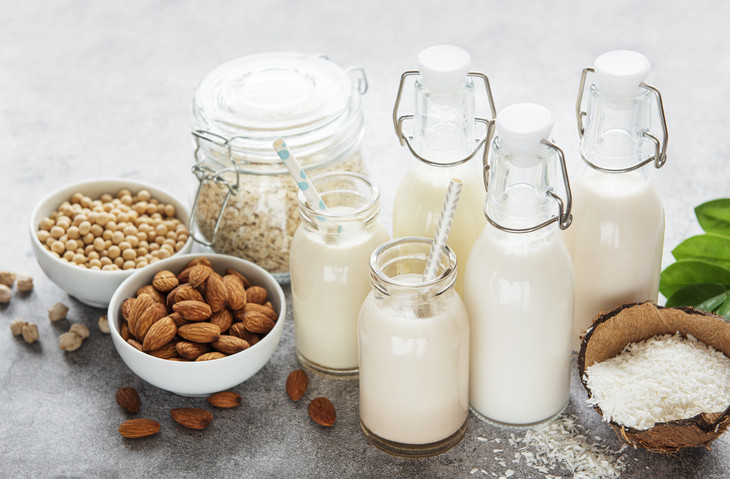The plant milk shake-up: Pea and pistachio join oat and almond

For the longest time, your milk choices were whole, 2%, 1%, and fat-free (or skim). Today, refrigerator shelves at grocery stores are crowded with plant-based milks made from nuts, beans, or grains, and include favorites like almond, soy, coconut, cashew, oat, and rice. Yet the fertile ground of the plant-milk business continues to sprout new options, such as pistachio, pea, and even potato milk. It seems if you can grow it, you can make milk out of it.
So, are these new alternatives better nutritionally than the other plant milks — or just more of the same?
A few facts about plant-based milks
Plant-based milks are all made the same way: nuts, beans, or grains are ground into pulp, strained, and combined with water. You end up with only a small percentage of the actual plant — less than 10% for most brands. Nutrients like vitamin D, calcium, potassium, and protein are added in varying amounts. "Still, many alternative milks have similar amounts of these nutrients compared with cow's milk," says Dr. Walter Willett, professor of epidemiology and nutrition at the Harvard T.H. Chan School of Public Health.
Plant-based milks are considered "greener" than dairy and emit fewer greenhouse gases during production. However, growing some of these plants and making them into milk requires great quantities of water. Most plant-based milks are low-calorie. On average, though, these milk products cost more than dairy.
Nutrition, calories, and other benefits of newer plant-based milks
Here's a closer look at three new members of the alternative-milk family.
- Pistachio milk is not green like the nut, but rather an off-brown color. Because it contains little actual pistachio, you miss out on the nuts' essential vitamins and minerals, like thiamin, manganese, and vitamin B6. Yet pistachio milk contains less than 100 calories per cup, which is similar to skim cow's milk and other plant-based milks. One extra benefit of pistachio milk is that it's a bit higher in protein than other plant milks (which can be light in the protein department compared with cow's milk).
- Pea milk is created from yellow field peas, but has no "pea-like" flavor. Its color, taste, and creamy consistency are close to dairy, so people may find it more appealing than the sometimes-watery texture of other plant milks. Pea milk has a decent protein punch — at least 7 grams per serving — and each serving adds up to about 100 calories. It also requires less water in production than other plant milks, and has a smaller carbon footprint than dairy.
- Potato milk looks more like regular dairy milk than other plant milks because of the potato's starchy nature. It's arguably the most eco-conscious plant milk, because growing potatoes requires less land and water than dairy and other plants. Potato milk also is low-calorie: 80 to 100 per serving.
What's the best plant-based milk for you?
There doesn't appear to be a huge difference between most plant milks. Ultimately, three issues drive your choice: digestion issues, environmental impact, and personal taste.
Digestion issues. Plant-based milks are a quality alternative for people with lactose intolerance or lactose sensitivity whose bodies can't break down and digest lactose, the sugar in milk. This causes digestive problems like diarrhea, gas, and bloating. (However, lactose-free and ultra-filtered dairy milk are available for those who prefer dairy.)
Environmental impact.One study in Science found that dairy milk production creates almost three times more greenhouse gas than plant-based milk. However, some plant milks, predominantly almond, demand much water to produce. (Some research suggests the water demands of almond milk are about equal to cow's milk, according to Dr. Willet.)
Still, if you want to do your part to fight climate change, buying plant-based instead of dairy is the greener choice.
Personal taste. Plant-based milks can be an acquired taste, but with multiple choices, there is a good chance you can find one that satisfies your taste buds. Manufacturers try to overcome the taste dilemma by pouring in extra sugar, sweeteners like vanilla and chocolate, and other additives. So always check the total and added sugar amounts and keep the amount per serving below 10%. Of course, the lower the amount, the better.
About the Author

Matthew Solan, Executive Editor, Harvard Men's Health Watch
Disclaimer:
As a service to our readers, Harvard Health Publishing provides access to our library of archived content. Please note the date of last review or update on all articles.
No content on this site, regardless of date, should ever be used as a substitute for direct medical advice from your doctor or other qualified clinician.
















